
Igalia started the Reforestation project in 2019. As one of the company’s Corporate Social Responsibility (CSR) efforts, the Reforestation project focuses on conserving and expanding native, old growth forests to capture, and long-term storing, carbon emissions. Partnering with Galnus, we have been working on reforestation of a 10.993 hectares area with 11,000 trees, which absorbs 66 tons of carbon dioxide each year.
Phase I – Rois
The first land where the project started was framed in the woods of the communal land of “San Miguel de Costa” in Rois. Rois is a municipality of northwestern Spain in the province of A Coruña in the autonomous community of Galicia. Environment in this land was highly altered by human action and the predominance of eucalyptus plantations left few examples of native forest.
After the agreement for land transfer signed on the 29th June 2019, the project started with creating maps and technical plans for the areas affected. Purposes of these plans are not only to build a cartographic base for management and accomplishment of the works but also to designate accurately these zones as “Reserved Areas” in future management plans.
Work carried out
- Clear and crush remaining eucalyptus and other exotic plants
Eucalyptus is an exotic and invasive species. It spread widely and had a negative impact on the environmental situation of this habitat. This work is to clear the existing growth and eliminate the regrowths of eucalyptus and other exotic plants before the start of planting work. In Q1 2020, 100% of exotic trees were cut as part of the Atlantic forest sponsorship. After that the focus was moved to eliminating the sprouts of eucalyptus grown from the seeds present in the soil in early years. Sprout and seeds elimination continues throughout the duration of the project.
- Acquire trees, shrubs and all other materials needed.
To improve forest structure and increase biodiversity for the affected area, the following native trees and shrubs were chosen and purchased in Q3 2019 –
– 1000 downy birch (Betula pubescens)
– 650 common oak (Quercus robur)
– 350 wild cherry (Prunus avium)
– 150 common holly (Ilex aquifolium)
A lot of other materials such as tree protectors, stakes etc. were also acquired at the time time.
- Planting
Planting started in Q4 2019, downy birches (Betula pubescens) and some common oaks (Quercus robur) were the first batch planted. This planting campaign continued in 2020 on the arrival of the rest of the trees.
- Care during the first year
The first year after planting is key to the future development and success of the project.
In Q1 2020, 100% of planted trees were already sprouting and alive. At this stage 100% of the restoration area has already been planted with at least 65% of the trees.
The first summer after planting is vital for the trees and shrubs to settle. During the first summer, trees adapt and take root in their new location. If they survive, their chances of developing correctly will increase exponentially and the following years they will be able to focus all their energy on their growth. The beginning of the summer 2020 was difficult due to hot and dry weather. However, the tree mortality rate remains within the expected range.
In Q4 2020, most of the planted trees are well-established and ready for spring sprouting. By Q1 2021 many of them have reached over 2 meters high.
The trees and shrubs settled happily after the first year of growth. This is the photo taken in Spring 2020
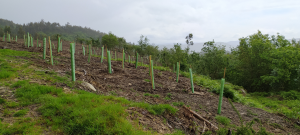
And see how they had grown in a year’s time –
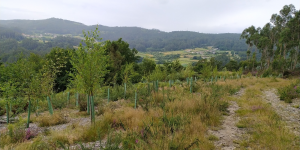
- Wildlife studies
With plants sprouting all around the forest, insects, reptiles and birds start thriving too. The development of the ecosystem will provide for better results in future inventories and wildlife studies. In summer 2020 the wildlife studies started and first inventory was completed. In winter 2020 wildlife nest boxes were in the manufacturing process and some bat boxes were installed in Spring 2021.
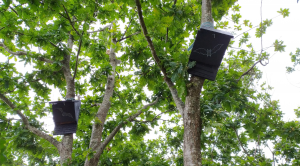
- Improving biodiversity
In addition to ensuring the introduction of a wide variety of tree species to reforestation areas, the project has also put effort on enhancing biodiversity in existing forest areas. For example, One of the areas targeted by the project is one hectare of young secondary forest made up mainly of oaks (Quercus robur). In this forest we have been planting understory species such as holly (Ilex aquifolium), laurel (Laurus nobilis) or Atlantic pear (Pyrus cordata) to increase biodiversity and improve the structure and complexity of the forest.
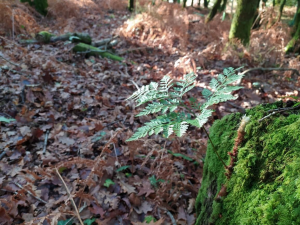
Phase II – Eume and Rois
Phase II of the reforestation project set sail in winter 2020. While the Rois project had moved to a steady stage with most trees and shrubs planted and settled through the first year’s growth, this phase is to expand restoration of new forest area in Rois and to start a new project in “Fragas do Eume” natural park.
- Rois
In order to explain the progress in the Rois expansion project, the maps below distinguish three areas in different stages of development.
– Phase 1 (Green) – The green area is completely planted with native trees and free of eucalyptus sprouts.
– Phase 2 (Yellow) – Acacias have been eliminated in this area. The work to control this species and also the eucalyptus trees will continue.
– Phase 3 (Red) – The entire area is covered with dense plantations of eucalyptus and acacia. Work is in the preparation stage.
The following maps represent the progresses made between Spring to Fall in 2021.
Spring 2021:
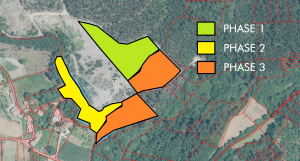
Fall 2021:
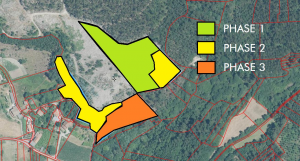
- Eume
Unlike the Rois project, habitats in “Fragas do Eume” natural park are some of the largest and best preserved examples in the world of coastal Atlantic rainforest, where much of its biodiversity and original structure is still preserved. Unfortunately, most of these forests are young secondary forests under numerous threats such as the presence of eucalyptus and other invasive species.
Our project represents one of the largest actions in recent years for the elimination and control of exotic species and the restoration of native forest in the area, increasing native forest surface area, reconnecting fragmented forest patches and improving the landscape in the “Fragas do Eume Natural Park”.
In order to explain the progress in the Eume project, it also distinguishes three areas in different stages of development.
Phase 1 (Green) – All the environmental restoration works have been completed. Only maintenance tasks remain for the next few years.
phase 2 (Yellow) – This area is in the process of control and elimination of eucalyptus to start the restoration of native vegetation with native trees plantation works.
Phase 3 (Red) – Waiting for the loggers to cut the big eucalyptus trees in this area, in order to start the work associated with the project.
The following maps represent the progresses made between Spring to Fall in 2021.
Spring 2021:
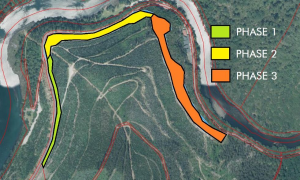
Fall 2021:
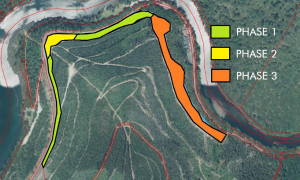
Esmelle
In 2021 Igalia started working on a 0.538-hectare land owned by the Esmelle Valley Association. This land is borded by a road and a forest track on each side, and the Esmelle stream flows across it. This once mighty stream and its tributary springs are currently used to provide drinking water to the houses in the surrounding area. Unfortunately, in summer time, the flow of the stream could reduce drastically due to dry weather and exhausting uses. In addition, this area also suffers invasion of numerous eucalyptus trees and other exotic species. Recovering and restoring a good example of the Atlantic Forest will bring great benefit to this enormously altered and humanized case.
After work preparation and planning, major work were carried out in 2022 including –
– Elimination and control of eucalyptus and its sprouts.
– Clearing and ground preparation
– Tree seedling, plantation and protections (placement of tree stakes and protectors etc.)
– Maintenance and replacement of dead trees
This work will continue in the next two years. Main focus will be on reinforcement and enrichment of the plantation based on the availability of tree seedlings of certain species, and finishing all the remaining maintenance work.
What’s next?
Igalia sees Reforestation as a long term effort. While maintaining and developing the current projects, Igalia doesn’t stop looking for new candidates. In Q4 2022, Igalia started preparing a new Reforestation project – Galnus: O Courel.
This is the first time that Igalia considered developing an environmental compensation project in one of the most rural and least densely populated areas of Galicia. Igalia believes that the environmental, social and economic characteristics associated with this area, offers an opportunity to carry out
environmental restoration projects. If it goes as planned, major work will happen in the next two years. Something to look forward to!
Impacts
The Reforestation project is making contributions to our environment, and it has gone further. Here we’d like to share a picture of a 7-year-old boy’s work. This young student is from the community owning the Rois forest. He took advantage of a school newspaper project to communicate about our work in Rois forest.

Isn’t it a joy to see Iglaia’s Reforestation project is making impacts on our children, and our future? 🙂